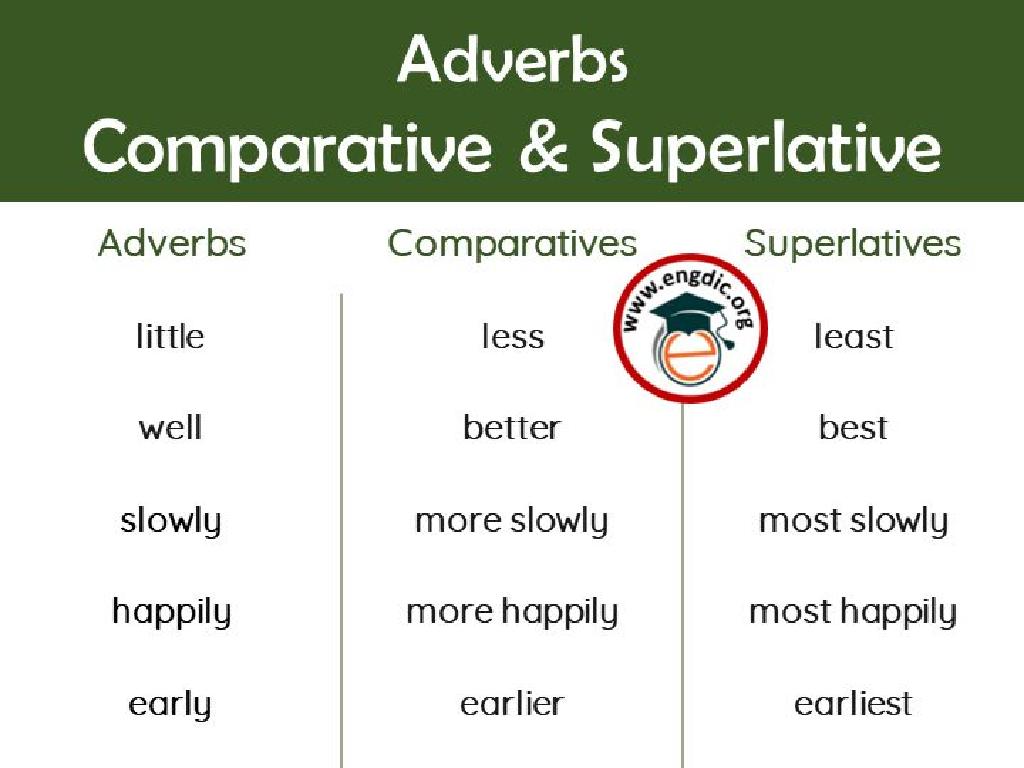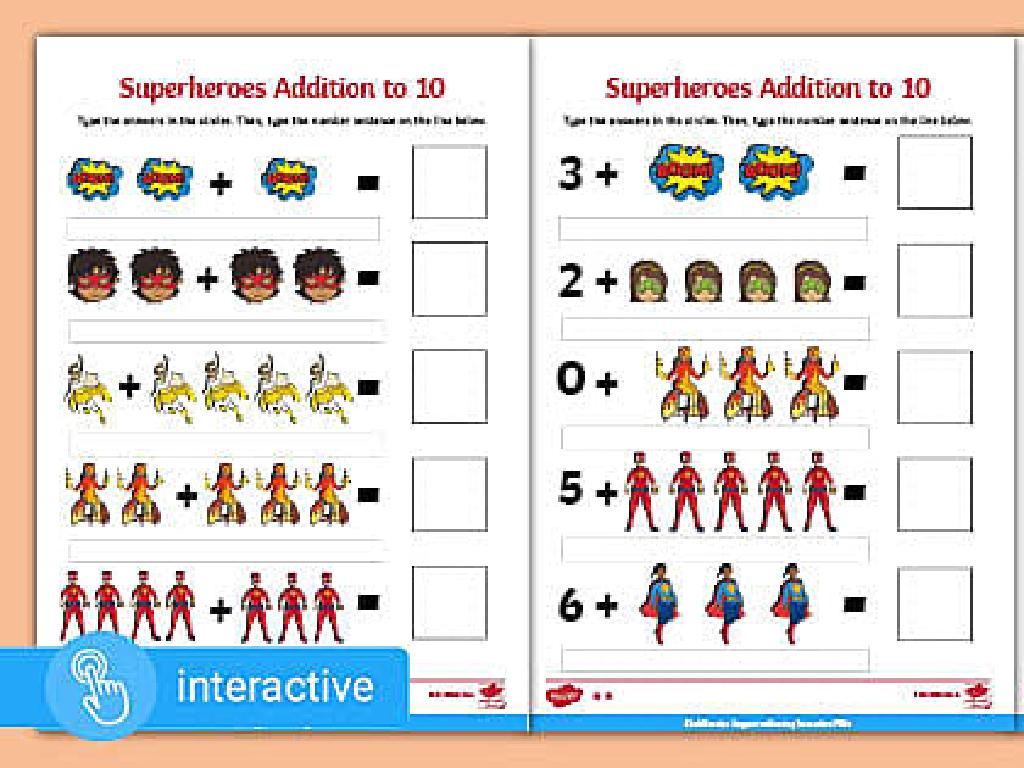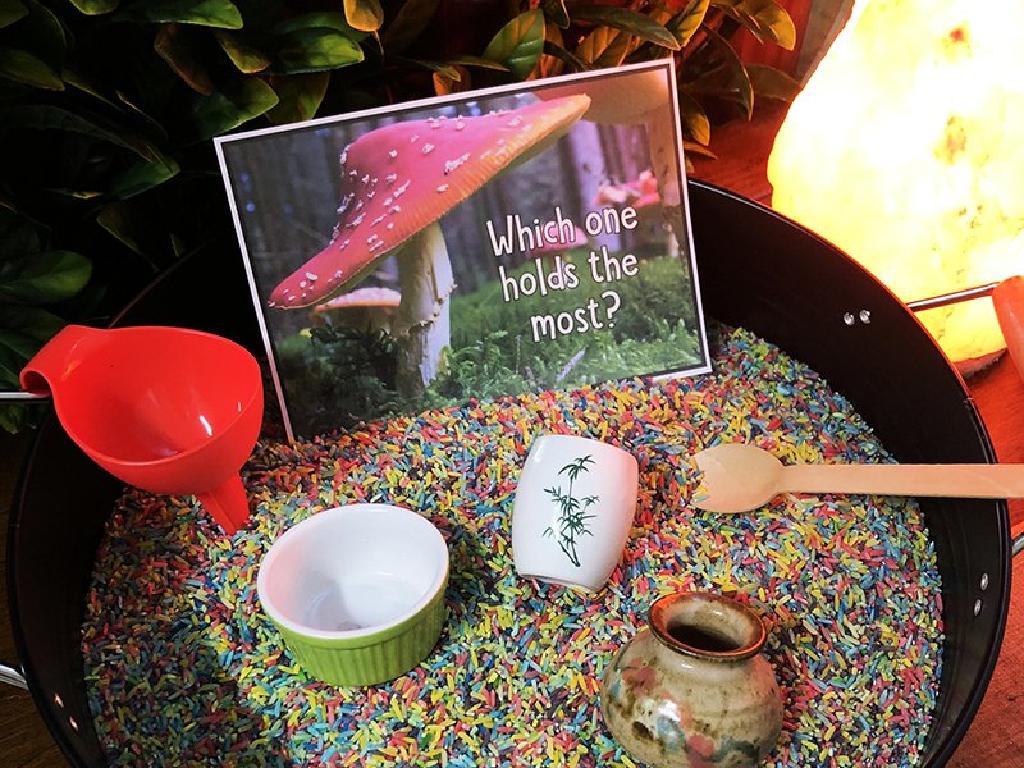Choose The Number That You Hear - 0 To 5
Subject: Math
Grade: Kindergarten
Topic: Numbers To 5
Please LOG IN to download the presentation. Access is available to registered users only.
View More Content
Welcome to Numbers!
– Greet our little mathematicians
– Today’s focus: Numbers 0 to 5
– We’ll learn to recognize and say numbers 0, 1, 2, 3, 4, and 5.
– Numbers are all around us
– Look around, numbers can be found in many places: clocks, phones, houses!
– Let’s discover numbers together
– We’ll go on a number hunt in our classroom and in our books.
|
This slide is designed to introduce Kindergarten students to the concept of numbers, specifically 0 to 5. Start with a warm welcome to engage the children and create a friendly atmosphere. Emphasize that the day’s lesson will focus on the first six numbers, which are the building blocks of math. Highlight that numbers are a part of everyday life and can be found in common places, making the concept relatable. Encourage the children to participate in activities that involve identifying and counting numbers in the classroom or in storybooks. This interactive approach helps to solidify their understanding of numbers and their relevance.
What Are Numbers?
– Numbers help us count
– Numbers show how many
– Count fingers 0 to 5
– Hold up fingers and count together
– Practice with fun activities
– Use toys or snacks to count from 0 to 5
|
This slide introduces the concept of numbers to Kindergarten students. Start by explaining that numbers are tools we use to find out how many of something we have. Demonstrate counting with familiar items like fingers, toys, or classroom objects. Engage the students by counting together from 0 to 5 using their fingers. This helps them visualize the concept of numbers and understand that each number corresponds to a quantity. For the activity, have various sets of items ready for the children to count, ensuring they grasp the idea of counting actual objects. Encourage them to count out loud and use their fingers to represent each number. This interactive approach will help solidify their understanding of the numbers 0 to 5.
Understanding the Number 0
– Zero means nothing
– When we say zero, it means there is none of something.
– Example: 0 cookies
– Imagine a plate with no cookies on it, that’s 0 cookies.
– Show 0 fingers
– Can you put your hands up and show no fingers? That’s 0!
– Recognizing zero
– Practice seeing the number 0 and understanding it means nothing.
|
This slide introduces the concept of the number zero to Kindergarten students. It’s important to convey that zero represents the absence of items or the concept of nothing. Use tangible examples like cookies to illustrate this point, as it’s relatable to the students. Encourage them to physically show zero by holding up a hand with no fingers extended. Reinforce the recognition of the number 0 by showing them the numeral and associating it with the absence of quantity. During the presentation, ask the students to participate by showing 0 fingers and identifying 0 in different scenarios to ensure comprehension.
Learning the Number 1
– One means a single item
– When we count, we start with number one for the first item
– Example: Having one apple
– If you see only one of something, like an apple, that’s 1
– Practice holding up 1 finger
– Can you show me one finger on your hand? That’s it!
|
This slide introduces the concept of the number 1 to Kindergarten students. It’s important to start with tangible examples they can relate to, like a single apple, to help them understand the idea of ‘one’. Encourage the students to physically engage with the concept by holding up one finger. This kinesthetic activity helps reinforce their understanding of the number. During the presentation, ask the students to look around the classroom and identify one of any item they see. This will make the learning experience interactive and fun.
Learning the Number 2
– Two represents a pair
– Examples: shoes and eyes
– We all have two eyes to see, two hands to clap!
– Practice holding up 2 fingers
– Show me two fingers, like bunny ears!
– Counting with the number 2
– Let’s count 1, 2 toys or steps together.
|
This slide introduces the concept of the number 2 to Kindergarten students by associating it with familiar pairs they encounter in everyday life, such as shoes and eyes. Encourage the children to hold up 2 fingers to physically represent the number, which helps with their motor skills and number recognition. Use visual aids like pictures of pairs of objects to reinforce the concept. During the class, engage the students in counting activities that involve the number 2 to solidify their understanding. For example, ask them to find objects in pairs around the classroom or at home as a fun activity.
Learning the Number 3
– Three follows two
– When we count, 3 comes after 2
– Three crayons, three colors
– Imagine coloring with red, blue, and yellow
– Show 3 fingers
– Can you hold up 3 fingers on one hand?
– Counting to 3 together
|
This slide is focused on helping Kindergarten students recognize and understand the number 3. Start by explaining that three is the number that comes right after two. Use visual aids like three crayons to show that three items allow for three different choices. Engage the students by asking them to show three fingers, which helps with number recognition and reinforces the concept of counting. Practice counting to three as a class to solidify their understanding. The goal is to make the students comfortable with the number 3 through repetition and interactive activities.
Learning the Number 4
– Four: two plus two
– Four wheels on a car
– Cars have 1, 2, 3, 4 wheels
– Show me 4 fingers
– Holding up fingers helps count
– Recognizing the number 4
– Practice saying ‘four’ aloud
|
This slide is focused on helping Kindergarten students recognize and understand the number 4. Start by explaining that four is the number that comes after three and before five. Use simple addition by combining two groups of two to illustrate the concept. Show a picture of a car and count the wheels together to reinforce the number. Engage the students by asking them to show four fingers and praise them when they do it correctly. Encourage them to practice saying the number ‘four’ and to look for groups of four in the classroom or at home. This interactive approach helps solidify their understanding of the number 4 through visual, auditory, and kinesthetic learning styles.
Learning About the Number 5
– Five equals one hand of fingers
– Count each finger on one hand to reach 5
– High-five uses all 5 fingers
– Slap hands together with all fingers – that’s 5!
– Show me your 5 fingers
– Let’s all raise our hands and count to 5 together
|
This slide is designed to help Kindergarten students visually and physically understand the concept of the number 5. Start by showing them one hand and counting each finger together to reach 5. Explain that when we give someone a high-five, we use all 5 fingers, and demonstrate this action. Encourage the children to participate by raising their hands and showing their 5 fingers, counting out loud from 1 to 5. This interactive approach helps solidify their understanding of the number 5 through a combination of visual, auditory, and kinesthetic learning styles. Make sure to praise their efforts and create a fun learning atmosphere.
Listening Game: Show Me the Number!
– Listen carefully to the number I say
– Show the number using your fingers
– Get ready to listen and play
– Can you show me the numbers 0 to 5?
Practice with numbers like 0 (no fingers), 5 (all fingers on one hand)
|
This interactive listening game is designed to help Kindergarten students recognize and understand numbers 0 to 5. The teacher will say a number out loud, and the students will respond by showing the number with their fingers. This activity reinforces number recognition and listening skills. Teachers should speak clearly and give students enough time to respond. It’s also beneficial to praise students for correct responses and gently correct any mistakes. Possible variations of the activity could include using number cards, having students say the number after showing it, or playing a ‘Simon Says’ version where students only respond when a certain phrase is used.
Class Activity: Number Hunt
– Let’s explore numbers with a hunt
– Find items matching numbers 0 to 5
– Look for 1 clock, 2 pencils, 3 books, etc.
– Pair up and count with a buddy
– Help each other and practice counting
– Have fun discovering numbers!
|
This interactive activity is designed to help Kindergarten students recognize and understand numbers 0 to 5 through a playful ‘number hunt’ in the classroom. Encourage the children to work in pairs to foster teamwork and communication. They should look for groups of objects that correspond to the numbers 0 to 5, such as 4 blocks or 5 crayons, and count them out loud together. This will help reinforce their counting skills and number recognition in a real-world context. Provide guidance and ensure each pair has a chance to share their findings with the class. Possible variations of the activity could include finding objects of a certain color that match the number, or even a timed hunt to make it more challenging.






